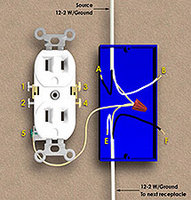
| Understanding the fundamentals of electrical wiring can be valuable, particularly when you’re making simple repairs or home improvements. |
| Three-Way Switches A three-way switch, for example, is commonly used in lighting circuits to turn a light on and off from two locations. They are often used at either end of a hallway or stairs. But if one of these switches needed replacement, do you have the knowledge to wire it correctly? Ground-Fualt Circuit Interrupters Knowing electrical wiring fundamentals can also keep you and your loved ones safe. Replacing a standard receptacle outlet with a ground-fault circuit interrupter (GFCI) can greatly reduce the risk of a shock or fire. GFCI’s are similar to fuses or circuit breakers, only much more sensitive to electrical faults. But, unlike fuses or circuit breakers that depend on heavy overloads to function, GFCI’s sense very small electrical faults, and cut power instantly before anyone is injured. In fact, the National Electrical Code requires them on receptacles in bathrooms, garages, around pools, and on all outside receptacles. Resources To Use With this brief review of GFCI’s and three-way switches, where do you go next to understand wiring fundamentals? You’ll need a book that illustrates several common circuits used for lighting and receptacle outlets. Full-color illustrations are best, because you can quickly see where each color wire should go. Any library will have books on this topic, or you can purchase one from local home centers or hardware stores. One interesting teaching aid uses the power of your home computer to explain electrical wiring. “Safe Electrical Wiring Techniques” uses on-screen color graphics and interactive exercises to assemble the most common types of electrical circuits. As a circuit is shown on the screen, the user must point and click where each wire should go. The on-screen exercises go from basic concepts, all the way to point-and-click assembly of lighting circuits, receptacles, and service panels. With some practice, the user can then go inside example buildings to wire the lights and outlets. The CD runs on nearly all home computers, and costs $97 (includes shipping). To learn more, contact the National Food and Energy Council at 1-937-383-0001 or visit www.nfec.org under “Materials to Order” to view example graphics. Courtesy: Home Improvement News and Information Center |










